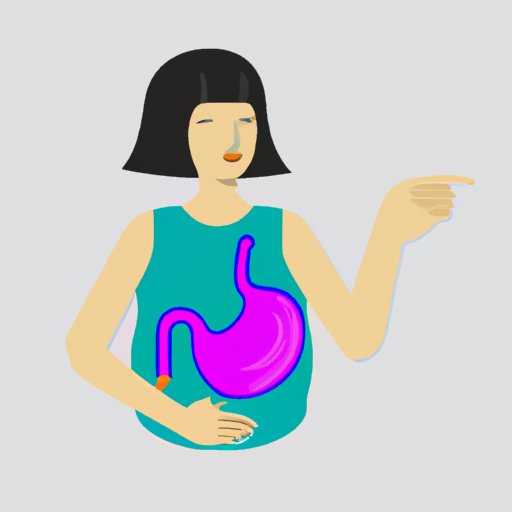
A Comprehensive Guide to Diagnosing Stomach Ulcers
If you’re experiencing pain or discomfort in your stomach, it may be a sign of a stomach ulcer. Stomach ulcers are sores that develop in the lining of the stomach or small intestine. Although it can be hard to tell if you have a stomach ulcer, diagnosing it early can help prevent complications or even surgery. In this article, we provide valuable information to help you recognize symptoms, causes, and diagnostic tests for stomach ulcers, as well as when to seek medical help.
A Comprehensive Guide to the Symptoms and Causes of Stomach Ulcers
A stomach ulcer is a condition that can be hard to recognize because its symptoms often overlap with other medical conditions. In general, it is a sore or erosion of the lining of the stomach. Stomach ulcer symptoms can range from mild discomfort to extreme discomfort, and in rare cases, severe bleeding. Here are the common symptoms and causes of stomach ulcers:
Definition of Stomach Ulcers
When the stomach’s protective lining breaks down, gastric acid may damage the stomach lining. This may cause an ulcer to form. Stomach ulcers can develop in the lining of the stomach or the small intestine. Although gastric acid is the primary cause of ulcers, other factors such as bacteria and other medications can also contribute to the formation of stomach ulcers.
Symptoms of Stomach Ulcers
Although stomach ulcers do not cause any symptoms in some people, they can cause inconvenient problems in others. Here are some common symptoms of stomach ulcers:
Pain or discomfort in the upper abdomen
The most common symptom of a stomach ulcer is upper abdominal pain or discomfort. The pain is usually described as a burning or gnawing sensation and typically fades or worsens in cycles. Pain is often greater when the stomach is empty; it’s why many people experience pain overnight.
Nausea and vomiting
People with stomach ulcers may feel nauseated. Vomiting may also occur in some cases.
Loss of appetite
Inability to eat, known as appetite loss, might occur in individuals with stomach ulcers. This can cause weight loss.
Weight loss
Significant weight loss is a sign that an ulcer may have formed.
Causes of Stomach Ulcers
The two most common causes of stomach ulcers are Helicobacter pylori (H. pylori) bacterial infection and the use of nonsteroidal anti-inflammatory drugs (NSAIDs). The following causes can lead to the development of stomach ulcers:
Helicobacter pylori infection
H. pylori is a bacterial germ that can penetrate the stomach lining and cause inflammation, resulting in ulcers. H. pylori infection can be transmitted through fecal-oral, oral-oral, and other contact mechanisms.
Regular use of nonsteroidal anti-inflammatory drugs (NSAIDs)
Regular use of pain relievers such as aspirin and ibuprofen can contribute to the development of stomach ulcers. NSAIDs like these can limit the production of mucus that helps protect the lining of the stomach.
Excessive alcohol consumption
Excessive and long-term alcohol intake can damage the lining of the stomach and increase the risk of stomach ulcers.
Smoking
Long-term smokers are frequently at risk of stomach ulcers, and they could experience more serious symptoms than individuals who have never smoked.

How to Detect Stomach Ulcers at Home:
Because stomach ulcers can cause symptoms that overlap with other medical conditions, it’s not uncommon for people to misdiagnose themselves. However, you can detect stomach ulcers early by looking out for the following indicators:
Changes in stool color
Stool color changes may occur if an ulcer starts to bleed. Black or tarry stools indicate that blood is present in them. Red blood in the stool or vomit indicates active bleeding.
Abdominal pain and tenderness
Abdominal pain that persists for several months can indicate a stomach ulcer. Abdominal pain typically feels like a burning sensation or pressure in the middle of your abdomen.
Nausea and vomiting
A continuously upset stomach can indicate an ulcer. Vomiting may also occur in some cases, and in severe cases, vomiting blood may indicate an active bleed.
Blood in stool or vomit
If you see blood in your stool, it may have come from an ulcer that has started to bleed. Contact your doctor immediately if you see this symptom.
Weight loss
Stomach ulcers can often cause weight loss.
Common Diagnostic Tests for Stomach Ulcers
When you suspect you have a stomach ulcer or other digestive concerns, you should make an appointment with your physician who may order a diagnostic test. The following are the most common diagnostic tests for stomach ulcers:
Blood tests
A blood test can detect signs of H. pylori infection, anemia (a result of blood loss from ulceration), or organ dysfunction.
Stool tests
Fecal tests can detect the presence of H. pylori antigens. Blood in the stool may indicate more serious bleeding from an active ulcer.
Endoscopy
Endoscopy is a diagnostic procedure in which a thin tube is inserted through the mouth and into the stomach to visualize the lining of the digestive tract. This painless procedure is the most effective way to detect ulcers.
Stomach Ulcer Tests You Should Take
If your doctor suspects you have a stomach ulcer, they may recommend some specific tests to help them diagnose the condition properly.
Tests Recommended by Doctors
Breath Test for H. pylori
A person drinks a liquid containing radioactive carbon, which breaks down into carbon dioxide. The person then blows into a bag, and the carbon dioxide gas gets trapped. The bag is then measured for carbon-14 levels.
Stool Antigen Test for H. pylori
This test checks for the presence of H. pylori antigens in feces. The test is non-invasive and does not cause discomfort.
Upper Endoscopy
An upper endoscopy is done to see the lining of the stomach and small intestine. After sedation, a long, thin tube with a camera on the end is inserted into the mouth towards the stomach. This procedure usually lasts for 30 minutes, and you’ll receive medication to make you more at ease.
Biopsy
A small sample of the suspicious lining is removed with biopsy forceps and examined to determine the extent of inflammation or bleeding. Biopsies can detect the presence of H. pylori.
When to Seek Help for a Stomach Ulcer
If you think you have stomach ulcers, make an appointment with your physician as soon as possible. Some individuals may delay treatment or ignore their symptoms, leading to complications.
Warning Signs That Indicate The Need For A Doctor’s Evaluation
Severe abdominal pain
If the abdominal pain is so severe that you can’t stand up straight or it’s interfering with your daily activities, it’s time to see a doctor.
Sudden weight loss
If you lose weight without hoping for it or trying to lose weight, contact your doctor to see whether stomach ulcers are responsible.
Vomiting blood or passing black, tarry stools
When this symptom arises, you should seek medical attention immediately. It is a sign of active bleeding which needs urgent care.
Difficulty Breathing
Difficulty breathing along with other symptoms may indicate a more severe complication of stomach ulcers, such as a perforated ulcer. Seek immediate medical attention if you have difficulty breathing with abdominal pain, fever, and shortness of breath.
Misdiagnosis of Stomach Ulcers
Misdiagnosis occurs when symptoms from other medical conditions that resemble those of ulcers are mistaken for ulcers. These are a few examples of conditions that can be misdiagnosed as stomach ulcers:
Acid Reflux
Acid reflux and peptic ulcers have similar symptoms, but they have different causes. Acid reflux is characterized by a feeling of heartburn and a bad taste in the mouth. Acid reflux is linked to stomach acid flowing back into the esophagus.
Irritable Bowel Syndrome
Irritable bowel syndrome (IBS) and ulcers share many symptoms, however, IBS symptoms are frequent bouts of diarrhea and the presence of abdominal cramps that are relieved by defecation.
Implications of Misdiagnosis
Misdiagnosis of stomach ulcers can lead to additional medical issues, delayed diagnosis, and prolonged symptoms. Because stomach ulcers require immediate treatment to prevent complications, it’s essential to get the right diagnosis.
Conclusion
Stomach ulcers can be life-threatening without early diagnosis and treatment. Discuss your symptoms with your healthcare provider to identify their cause, as putting a name to it might help you get relief sooner. Seeking early medical attention, undergoing testing, and following up with a gastroenterologist can aid in the management of stomach ulcers and enhance the quality of life.
Takeaway Message
Stomach ulcers are a prevalent medical condition. They can cause pain, discomfort, and bleeding in some cases. Make sure you schedule an appointment with a healthcare provider if you suspect you have a stomach ulcer. Early detection and treatment can help lead to a better quality of life.




